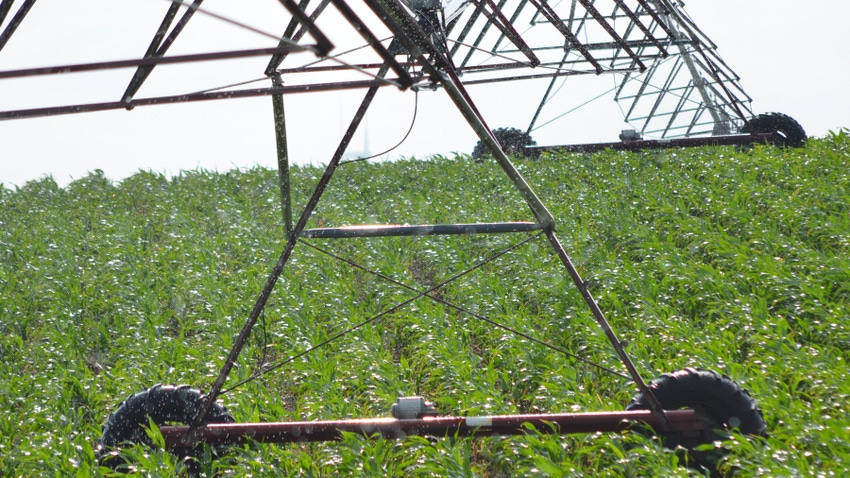
Fertilizer prices and availability, along with environmental concerns — particularly with nitrogen and phosphorus — have driven farmers to administer crop nutrients with a miserly approach. Producers want every drop to count.
Such nutrient management becomes even more crucial with irrigated corn. But thankfully, new game-changing technologies have been developed in the past couple of years to boost fertigation efficiency to previously unseen levels.
Using sensor-based fertigation management systems, such as Nebraska-based Sentinel Fertigation, which was founded by Jackson Stansell, has evolved enough today that some producers can actually cut their total nitrogen applied by nearly half and still obtain similar yields.
With the price tag of fertilizer, that is a big deal, says Joe Luck, Nebraska Extension precision agriculture engineer. Over the past four years of research across around 20 fields, even compared to sensors mounted on high-clearance machines going through the fields, the sensor-based systems applying nitrogen through fertigation with center pivots have cut nitrogen use down to 0.55 to 0.65 pounds of N (applied as fertilizer) per bushel of corn produced, Luck says.
Timing counts
“It is not necessarily the variable rate that has allowed us to do this,” Luck says. “It is the timing and measuring current crop N status. We often focus on a forecasted rate, which is fine, but I think we have more benefits if we time things better and use sensors, because we match crop need and uptake better.”
For years, researchers have known that spoon-feeding nutrients to the crop in-season is vastly superior to front-loading fertilizer needs in the fall or at the beginning of the growing season, because you are only applying what the plant needs.
Sensor-based fertigation or nutrient application in-season basically uses the plant as a monitoring tool to tell producers when it needs nutrients, Luck says. “We are able to get aerial imagery every other day now, so we have an idea of what nitrogen stress looks like,” he notes.
Using plants as biological sensors to tell the operator when they need nitrogen between V6 and R3 last year, as an example, yielded 277 bushels of corn per acre with only 96 pounds of fertilizer-applied N, Luck says.
“People are shocked,” he says. “We saved up to $95 per acre in some fields” without giving up on yield. Now, even Natural Resources Districts such as Central Platte NRD are looking at ways in which such technology can help to reduce nitrogen use in the district and protect groundwater quality.
The research that has culminated in the development of Sentinel Fertigation has been ongoing for more than 20 years. Early research used hand-held sensors to determine nitrogen stress for individual plants and evolved through what is known as Project SENSE.
“For a long time, the barrier was that this method was labor intensive,” Luck says. “And it was taking point data, so depending on which corn plant you measured, the readings would vary quite a bit.”
The breakthrough
But in 2018, researchers began understanding the remote sensing piece of the puzzle, using UAV sensors or satellite data, which provides multispectral imagery. Now, there are flights over the Corn Belt every other day that have enabled a real breakthrough in the technology.
Stansell had a summer internship in 2017 at the University of Nebraska, working on managing crop nitrogen needs following a rye cover crop through in-field evaluation. The research used hand-held sensors, as mentioned by Luck, and cameras mounted on drones.
This research planted the idea of his concept with Stansell. His master’s degree research included the development and validation of a sensor-based fertigation management framework developed with significant contributions from Brian Krienke, former Nebraska Extension soils educator, through on-farm research.
Stansell’s development of software to facilitate implementation led to the establishment of Sentinel Fertigation. More recently, Taylor Cross, graduate student at UNL, has managed the research and demonstration sites, which have shown improved N use efficiency and profitability potential each year.
For Luck, the other key component of the development of this technology was the connection to the needs of growers. “We were working with farmers through on-farm research,” he says. “If we didn’t have that connection with growers, it wouldn’t have worked.”
So, what’s next for fertilizer use efficiency? Luck believes that the aerial imagery used to detect nitrogen stress and needs in the plants can be used in other ways beyond nitrogen. No matter what lies in the future, with this new breakthrough in irrigated corn nitrogen management, farmers can spoon-feed the crop with good confidence, without front-loading nitrogen needs before the crop is even planted.
To learn more, email Luck at [email protected].
About the Author(s)
You May Also Like






